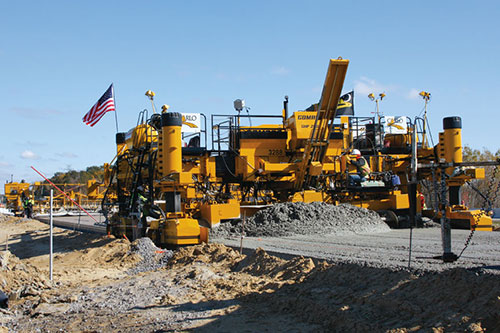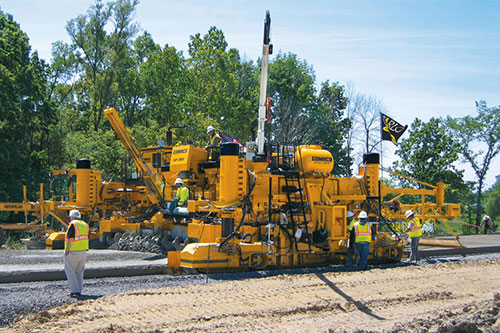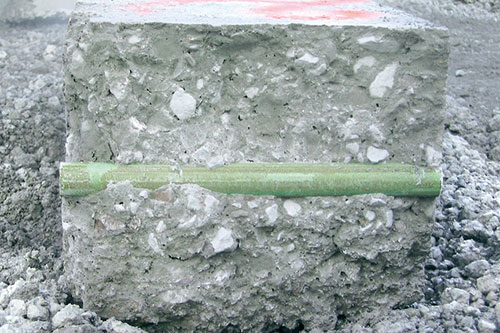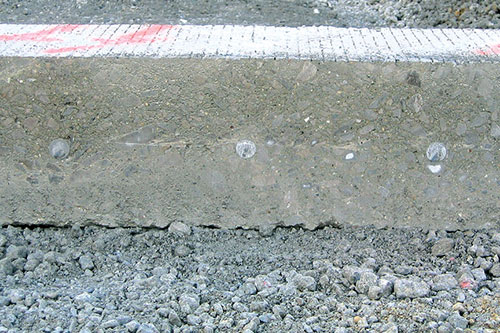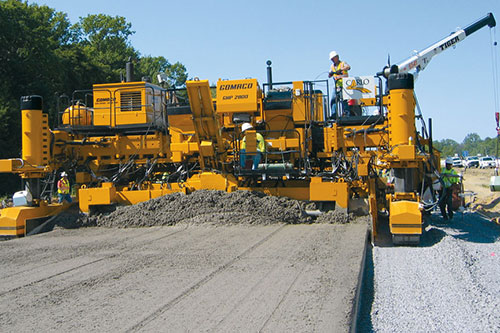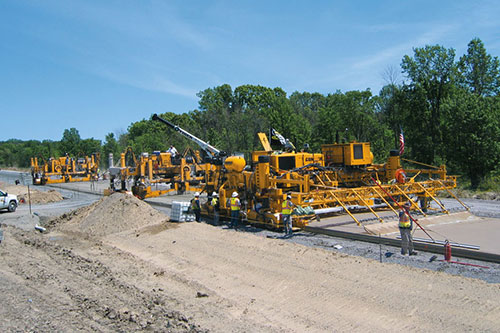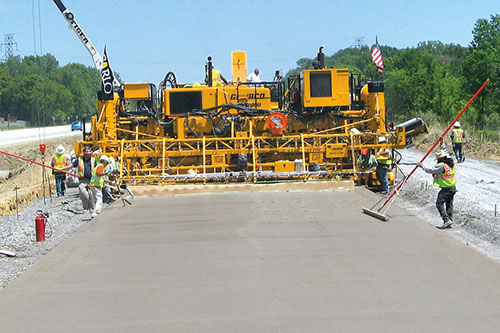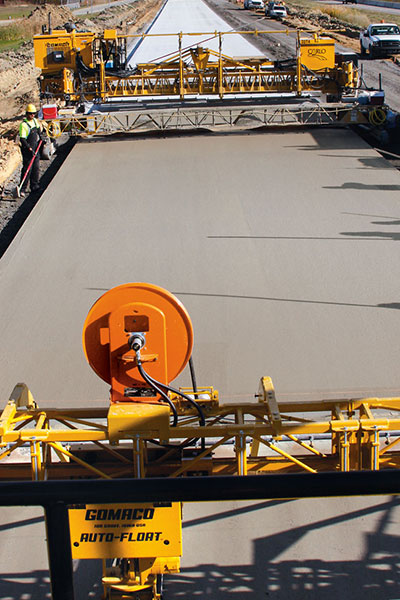GOMACO World Index --- GOMACO World 37.2 - September 2009
A GOMACO Paving Train Gets the Job Done With or Without an IDBI
The GOMACO GHP-2800 slipformed the eastbound lanes over baskets. The paver is equipped with a detachable auger/strike-off.
John Carlo Inc., based out of Clinton Township, Michigan, just completed rebuilding a 6.2 mile (10 km) stretch of Interstate 94. They purchased a new GOMACO four-track GHP-2800 paver for the project and achieved some excellent production results. Carlo’s ride is also being measured by one of the most challenging indexes in the industry, the International Roughness Index (IRI). The Michigan Department of Transportation (MDOT) utilizes the IRI for their smoothness requirement.
Carlo completed the first phase of the project, the eastbound lanes, last year paving over baskets. This year they added an In-the-Pan Dowel Bar Inserter (IDBI) to the GHP-2800 for the westbound portion of the project.
“The MDOT specification for ride quality requires an IRI of less than 75, which is a very tight spec in the IRI format,” Chris Mondon, Concrete Quality Control for John Carlo, said. “On the east lanes of pavement, we obtained an IRI of 64.2.”
IRI readings on the westbound lanes, using the IDBI, were also well under the requirement of 75. They averaged 69.8 for smoothness while inserting the bars to form the transverse joint on-the-go. Carlo’s key to good concrete pavement is simple... keep the paver moving and eliminate any unnecessary stops.
“Our main goal is just to keep the paver moving at a constant speed,” Jason Beem, Assistant Manager of the John Carlo Paving Division, said. “If the paver doesn’t stop all day, we know we can reach our desired production. It also gives us our best chance at getting quality ride. When the paver has to stop, that’s when we end up having problems. We try to keep a nice five to six foot (1.5 to 1.8 m) per minute pace, which keeps things simple for the operator and gives us the ride quality we’re looking for.”
They accomplished an excellent IRI result and superior daily production while inserting bars accurately with the IDBI. MDOT had officials on site and Carlo also had their own quality control technician conducting tests to ensure accuracy.
“We had a quality control technician on site doing depth checks every 100 feet (30 m) behind the paver,” Beem said. “He’s checking the depth of the bars and making sure we don’t have any issues from that side.
“MDOT also required that we complete test headers at the end of the day. We would pave past our header point, inserting one transverse joint with the IDBI. The next morning we came back, saw cut through that joint on either end of the bars and measured the vertical and horizontal tolerances. MDOT is very strict and we had to do this test for them five different times.”
According to Beem, the DOT approved their work and didn’t have any issues with the accuracy of the bar placement.
The new interstate is being built using 11 inch (279 mm) thick concrete on a 16 inch (406 mm) open-graded drainage course. Carlo’s new GOMACO GHP-2800 paver is equipped with some special features. It has the new G22 digital controller, with the second language in Spanish. The paver is equipped with a detachable auger/strike-off, so Carlo can use the mold as either an open front or an auger/strike-off for extra versatility. The GHP-2800 is also equipped with a Minnich Auto Vibe Control System for vibrator monitoring. It’s a required feature for Carlo’s airport paving projects.
Paving on I-94 began last year when Carlo paved the first phase of the project, the two eastbound lanes of I-94. Their paving train consisted of two placer/spreaders, the GHP-2800 paver and a new T/C-600 texture/cure machine.
“When we pave concrete, we like to dump off the haul road,” Beem explained. “We don’t like running trucks on the aggregate base because it can contaminate the stone. It also helps us to control our overrun, because we’re not rutting or disturbing the aggregate base.
“We use two spreaders out in front, because it helps with production. On this first phase, we averaged around 250 cubic yards (191 m3) per hour. We really try to push for 250 to 300 cubic yards (191 to 229 m3) per hour.”
Test headers with the IDBI system inserting a transverse joint were saw cut through the joint and horizontal and vertical tolerances were measured for bar placement. John Carlo had no problems achieving bar placement accuracy.
An on-site batch plant, located on the south-end of the project, is capable of producing the 300 cubic yards (229 m3) of concrete per hour to feed that kind of production. Tri-axle dump trucks carry 10 cubic yard (7.6 m3) loads of concrete to the placer/spreaders in front of the paver. The concrete is an MDOT high-performance mix with three aggregates, and ground-granulated blast furnace slag that is used as a cement supplement in the concrete. Slump averages 1.5 inches (38 mm).
The GHP-2800 paver slipformed the first paving pass 24 feet (7.3 m) wide, which included a 12 foot (3.7 m) driving lane and 12 foot (3.7 m) outside shoulder. The second paving pass included the other 12 foot (3.7 m) lane with a five foot (1.5 m) wide inside shoulder for a 17 foot (5.2 m) wide pass.
A front-mounted bar inserter on the GHP-2800 inserted a #5, 30 inch (762 mm) long straight bar every 23 inches (584 mm). Side-mounted bar inserters on the back of the paver inserted #5, 30 inch (762 mm) long bent bars every 18 inches (457 mm). Dowel baskets were placed on grade at 14 foot (4.3 m) intervals to form the transverse joint.
A GOMACO Auto-Float®, followed by a wet burlap drag mounted to the back of the paver, provided the final finish to the concrete slab. A T/C-600 texture/cure machine applied a white spray cure and longitudinal tine.
Paving on the eastbound lanes of Carlos’ I-94 project was completed late last year. Work on the westbound lanes was started in the spring of this year. This second phase of paving included the IDBI on the GHP-2800 paver.
“On mainline highway jobs using the IDBI, we can save a significant amount of labor and materials by not having to buy and set baskets,” Beem said. “Even with the initial costs of the IDBI, after a few large highway projects, it pays for itself.”
The GHP-2800 paved the westbound lanes of I-94 in a 24 foot (7.3 m) wide pass, which included both 12 foot (3.7 m) driving lanes. The five foot (1.5 m) and 12 foot (3.7 m) wide shoulders and various other ramps on the project were slipformed with a GOMACO four-track Commander III.
Carlo’s new IDBI inserted 24 bars at 12 inch (305 mm) spacings across the width of the pavement. Each bar was 1.25 inches (32 mm) in diameter, 18 inches (457 mm) long and epoxy coated. The bars were inserted 5.5 inches (140 mm) into the depth of the new road at 14 feet (4.3 m) intervals to form the transverse joint.
“The computer on the IDBI makes setting up the bar spacing easy for the crew,” Beem said. “We just program the spacing for the front-bar inserter, program the spacing for the dowel bars and where the joints are going to be, and the machine does everything itself.
“The GHP-2800 is the perfect sized piece of equipment to be competitive in the highway-paving market,” Beem said. “Add the IDBI to the paver, and it’s all we’ll use on multi-lane, multi-mile highway projects.”
Carlo is the prime contractor for rebuilding I-94, connecting St. Clair County to Macomb County, Michigan. I-94 goes on to cross St. Mary’s River, which is the international dividing point between Canada and the United States. The international crossing at Port Huron, in St. Clair County, is one of the busiest in North America.
Subscribe to Receive GOMACO World Magazine
